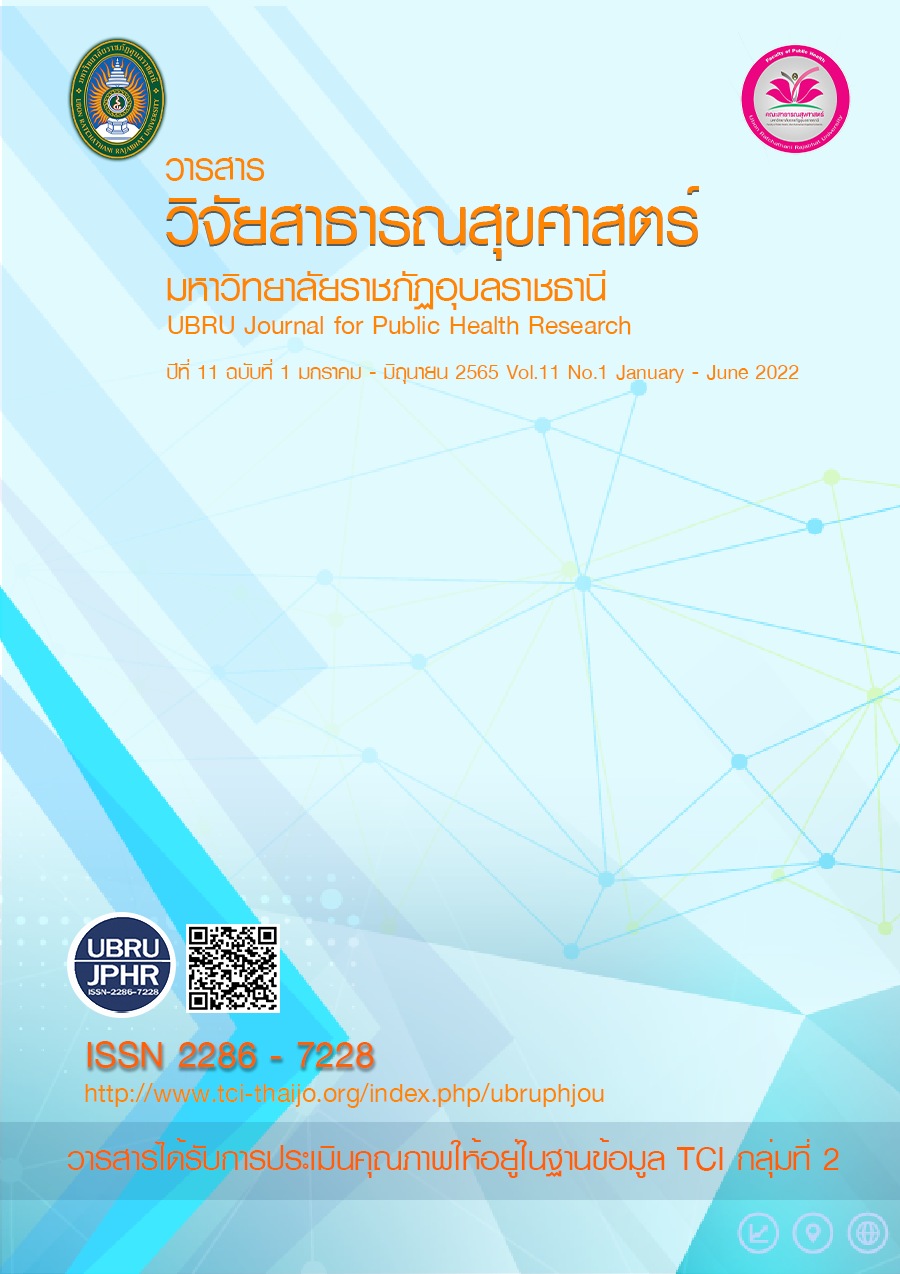การจัดการความเครียดของนักศึกษาระดับปริญญาตรี มหาวิทยาลัยราชภัฏ ศรีสะเกษระหว่างการแพร่ระบาดของ COVID-19
คำสำคัญ:
การจัดการความเครียด, ความเครียด, COVID-19บทคัดย่อ
การศึกษาครั้งนี้เป็นการศึกษาภาคตัดขวางเชิงสำรวจ ( Cross sectional Survey Study ) มีวัตถุประสงค์เพื่อศึกษาการจัดการความเครียดของนักศึกษาระดับปริญญาตรี มหาวิทยาลัยราชภัฏศรีสะเกษ ระหว่างการแพร่ระบาดของ COVID-19 โดยใช้แบบสอบถามการจัดการความเครียดของนักศึกษาระดับปริญญาตรี มหาวิทยาลัยราชภัฏศรีสะเกษ เก็บข้อมูลในกลุ่มตัวอย่าง 380 คน ในนักศึกษาระดับปริญญาตรี ภาคปกติ ชั้นปีที่ 1-4 มหาวิทยาลัยราชภัฏศรีสะเกษ ปีการศึกษา 2563 วิเคราะห์ข้อมูล และนำเสนอด้วยความถี่ ร้อยละ ค่าเฉลี่ย และส่วนเบี่ยงเบนมาตรฐาน
ผลการศึกษาพบว่ากลุ่มตัวอย่างส่วนใหญ่เป็นเพศหญิง ร้อยละ 72.90 อายุเฉลี่ย 21 ปี (S.D. =1.87) อายุต่ำสุด 19 ปี สูงสุด 24 ปี ส่วนใหญ่เรียนคณะครุศาสตร์ ร้อยละ 36.05 ในด้านผลการเรียน ส่วนใหญ่มีผลการเรียน เกรดเฉลี่ย (GPA) ระหว่าง 2.51 - 3.00 ร้อยละ 46.58 มีรายได้เฉลี่ยต่อเดือนส่วนใหญ่ 2,501 – 3,000 บาท ร้อยละ 36.32 ลักษณะที่พักอาศัย พบว่าส่วนใหญ่พักหอนอก ร้อยละ 62.63 นักศึกษาส่วนใหญ่กู้ยืมกองทุนให้กู้ยืมเพื่อการศึกษา (กยศ) ร้อยละ 69.21 ภาพรวมนักศึกษามีการจัดการความเครียดในระดับปานกลาง (Mean=3.38, S.D. =1.18) คิดเป็นร้อยละ 52 เมื่อจำแนกรายข้อการจัดการความเครียดด้านบวก พบว่าเมื่อรู้สึกเครียดนักศึกษาจะฟังเพลง (Mean=3.94, S.D. =0.91) รองลงมาคือเมื่อรู้สึกเครียดนักศึกษาจะเล่น Facebook (Mean=3.80, S.D. =1.05) เมื่อจำแนกรายข้อการจัดการความเครียดด้านลบ พบว่าเมื่อนักศึกษาเครียดมาก ๆ นักศึกษามักจะทำร้ายผู้อื่น (Mean=3.82, S.D. =1.46) รองลงมาคือเมื่อรู้สึกเครียด นักศึกษาจะสูบบุหรี่ (Mean=3.78, S.D. =1.46)
สรุปจากผลการศึกษาดังกล่าวทำให้ทราบว่า นักศึกษาส่วนใหญ่จะใช้วิธีการจัดการความเครียดด้านบวกแบบมีประสิทธิภาพ ได้แก่ การฟังเพลง การเล่น Facebook แต่ยังมีนักศึกษา 2 ใน 5 มีการจัดการความเครียดด้านลบ คือการทำร้ายผู้อื่น และการสูบบุหรี่ ซึ่งจะเป็นข้อมูลเบื้องต้นในการวางแผนช่วยเหลือนักศึกษาคือ การจัดการความเครียดด้านบวกโดยการส่งเสริมให้นักศึกษามีกิจกรรมนันทนาการที่เน้นให้นักศึกษามีส่วนร่วม หรือจัดกิจกรรมสร้างสรรค์ผ่านการถ่ายทอดสดทาง Facebook การจัดการความเครียดด้านลบโดยการจัดกิจกรรมให้นักศึกษาได้แสดงออกถึงการระบายความเครียดเชิงบวกด้วยการออกกำลังกายเพื่อระบายความเครียด และการจัดกิจกรรมรณรงค์การไม่สูบบุหรี่
เอกสารอ้างอิง
กรมสุขภาพจิต. (2563) แบบประเมินความเครียด (Stress test-5: ST5) ค้นเมื่อวันที่ 23 ก.พ. 2563, จาก: https://www.dmh.go.th/ test/qtest5/.
กรมสุขภาพจิต. (2563) แบบสำรวจความเครียดของคนไทย. ค้นเมื่อวันที่ 10 เม.ย. 2564, จาก: https://www.dmh.go.th/news-dmh/.
กัญญาณัฐ เพ็ชรผ่อง, จุพามาศ เทพพิทักษ์ , ทรรศนีย์ บัวมาต, ทิพวรรณ คำล้าน, ธัญญารัตน์ พูนทองเสน, ธาดารัตน์ ลำสวย, เบญญาภา ยิ่งแก้ว และ โศรตรีแพน้อย. (2561, มีนาคม). ความเครียดและการ จัดการความเครียดของนักศึกษาพยาบาลศาสตร์ บัณฑิตชั้นปีที่ 1 วิทยาลัยพยาบาลบรมราชชนนี สุราษฎร์ธานี. การประชุมวิชาการระดับชาติ การเรียนรู้เชิงรุก ครั้งที่ 6. สุราษฎร์ธานี: วิทยาลัยพยาบาลบรมราชชนนี
ชวิศา แก้วอนันต์, วนิศรา มาชะนา, ศิรินันท์ ปุยะโท. (2562). ความเครียดและการจัดการความเครียดของนักศึกษามหาวิทยาลัยอีสเทิร์นเอเชีย. [ ฉบับอิเล็กทรอนิกส์]. วารสารวิชาการมหาวิทยาลัยอีสเทิร์นเอเชีย.13(2),159-174.
ปรารถนา สวัสดิสุธา และคณะ.(2559). การจัดการความเครียดของนักเรียนระดับมัธยมศึกษาตอนปลายในกรุงเทพมหานคร. [ ฉบับอิเล็กทรอนิกส์]. วารสารสมาคมจิตแพทย์แห่งประเทศไทย.61(1),41-52.
พนิดา สังฆพันธ์. (2556). ความเครียดและปัญหาสุขภาพจิตของนักศึกษาสัตวแพทยศาสตร์มหาวิทยาลัยขอนแก่น. [ ฉบับอิเล็กทรอนิกส์]. วารสารสัตวแพทยศาสตร์ มข, 3(2), 1-14.
มหาวิทยาลัยราชภัฏศรีสะเกษ, มหาวิทยาลัย. (2563).ข้อมูลนักศึกษา. ศรีสะเกษ : สำนักส่งเสริมและบริการวิชาการมหาวิทยาลัยราชภัฎ,
ยงยุทธ วงศ์ภิรมย์ศานต์.(2020). บทความพิเศษการดำเนินงานสุขภาพจิตภายใต้วิกฤติโควิด 19 ของประเทศไทย. [ ฉบับอิเล็กทรอนิกส์] วารสารสุขภาพจิตแห่งประเทศไทย 28(4), 280-291.
รวิวรรณ รุ่งไพรวัลย์, วิรงรอง อรัญนารถ, และชาคริยา ธีรเนตร. (2551). การกำกับดูแลสุขภาพเด็ก (child health supervision) . ใน นิชรา เรืองดารกานนท์, ชาคริยา ธีรเนตร, ววิวรรณ รุ่งไพรวัลย์, ทิพวรรณ หรรษคุณาชัย, และนิตยา คชภักดี (บรรณาธิการ).ตำราพัฒนาการและพฤติกรรมเด็ก (หน้า 3-35). กรุงเทพฯ: โฮลิสติก พับลิชชิ่ง.
สุริยา ยอดทอง, นันทยา เสนีย์ และจิรานุวัฒน์ ชาญสูงเนิน.(2560, กรกฎาคม). ความเครียดและการเผชิญความเครียดของนักศึกษาพยาบาลในการขึ้นฝึกปฏิบัติงานบนหอผู้ป่วยรายวิชาปฏิบัติหลักการและเทคนิคการพยาบาล วิทยาลัยพยาบาลบรมราชชนนีตรัง. การประชุมวิชาการหาดใหญ่วิชาการ ระดับชาติและนานาชาติ ครั้งที่ 9. หาดใหญ่. มหาวิทยาลัยหาดใหญ่.
Hammen C. (2005). Stress and depression. Annu Rev Clin Psychol; 1, 293-319.
Kaewmart, N.(2013). Nursing Students with Depression. The Journal of Faculty of Nursing Burapha University. 21(3), 14-23.
Lofmark, A., Carlsson, M., and Wikblad, K. (2001).Student nurses’ perception of independence of supervision during clinical nursing practice. Journal of Clinical Nursing, 10(1), 86-93.
Namakunka, A., et. al. (2008). Stress and Factors Inducing Stress in Nursing Students During Nurses Practice on Wards.Nursing Journal, 35(2), 26-36.
Pao-in (2010). Stress, coping and satisfaction in nursing students .Journal of Advanced Nursing, 67(3), 621-632.
Phochum, R. (2001). Causes of stress, level of stress, and coping strategies in nursing student, Faculty of Nursing at Mahidol University. Graduate School, Mahidol University.
Polit, D.F. & Beck, C.T. (2008). Nursing research: Generating and assign evidence for nursing practice. 8th ed. Philadelphia: Lippincott.
Sukcharoen, C. and Wuttaritrit, S. (2008). Factors Influencing on Stress and Coping Behavior of Nursing Students of Boromarajonani College of Nursing, Chon Buri.Boromarajonani college of nursing ChonBuri.
Weiers, Ronald M.(2005).Introduction to Business Statistics. International Student Edition.Fifth Edition.Pennsylvania, USA. Duxbury Press, Thomson - Brooks/cole.
ดาวน์โหลด
เผยแพร่แล้ว
รูปแบบการอ้างอิง
ฉบับ
ประเภทบทความ
สัญญาอนุญาต
ลิขสิทธิ์ (c) 2022 คณะสาธารณสุขศาสตร์ มหาวิทยาลัยราชภัฏอุบลราชธานี

อนุญาตภายใต้เงื่อนไข Creative Commons Attribution-NonCommercial-NoDerivatives 4.0 International License.
เนื้อหาและข้อมูลในบทความที่ลงตีพิมพ์ในวารสารวารสารวิจัยสาธารณสุขศาสตร์ มหาวิทยาลัยราชภัฏอุบลราชธานี ถือเป็นข้อคิดเห็นและความรับผิดชอบของผู้เขียนบทความโดยตรงซึ่งกองบรรณาธิการวารสาร ไม่จำเป็นต้องเห็นด้วย หรือร่วมรับผิดชอบใดๆ
บทความ ข้อมูล เนื้อหา รูปภาพ ฯลฯ ที่ได้รับการตีพิมพ์ในวารสารนี้ ถือเป็นลิขสิทธิ์ของวารสารฯ หากบุคคลหรือหน่วยงานใดต้องการนำทั้งหมดหรือส่วนหนึ่งส่วนใดไปเผยแพร่ต่อหรือเพื่อกระทำการใดๆ จะต้องได้รับอนุญาตเป็นลายลักอักษรณ์จากบรรณาธิการวารสารนี้ก่อนเท่านั้น


